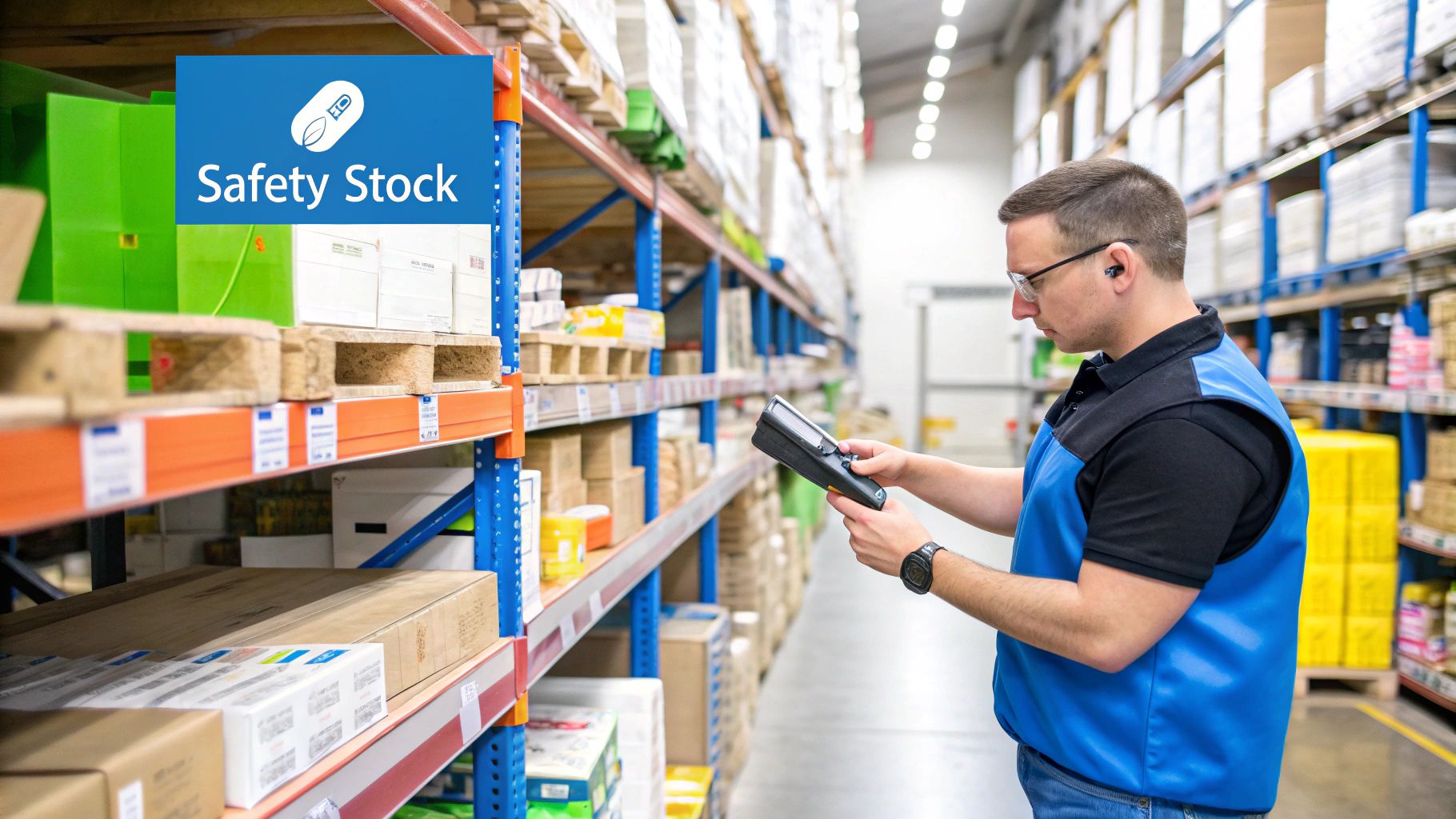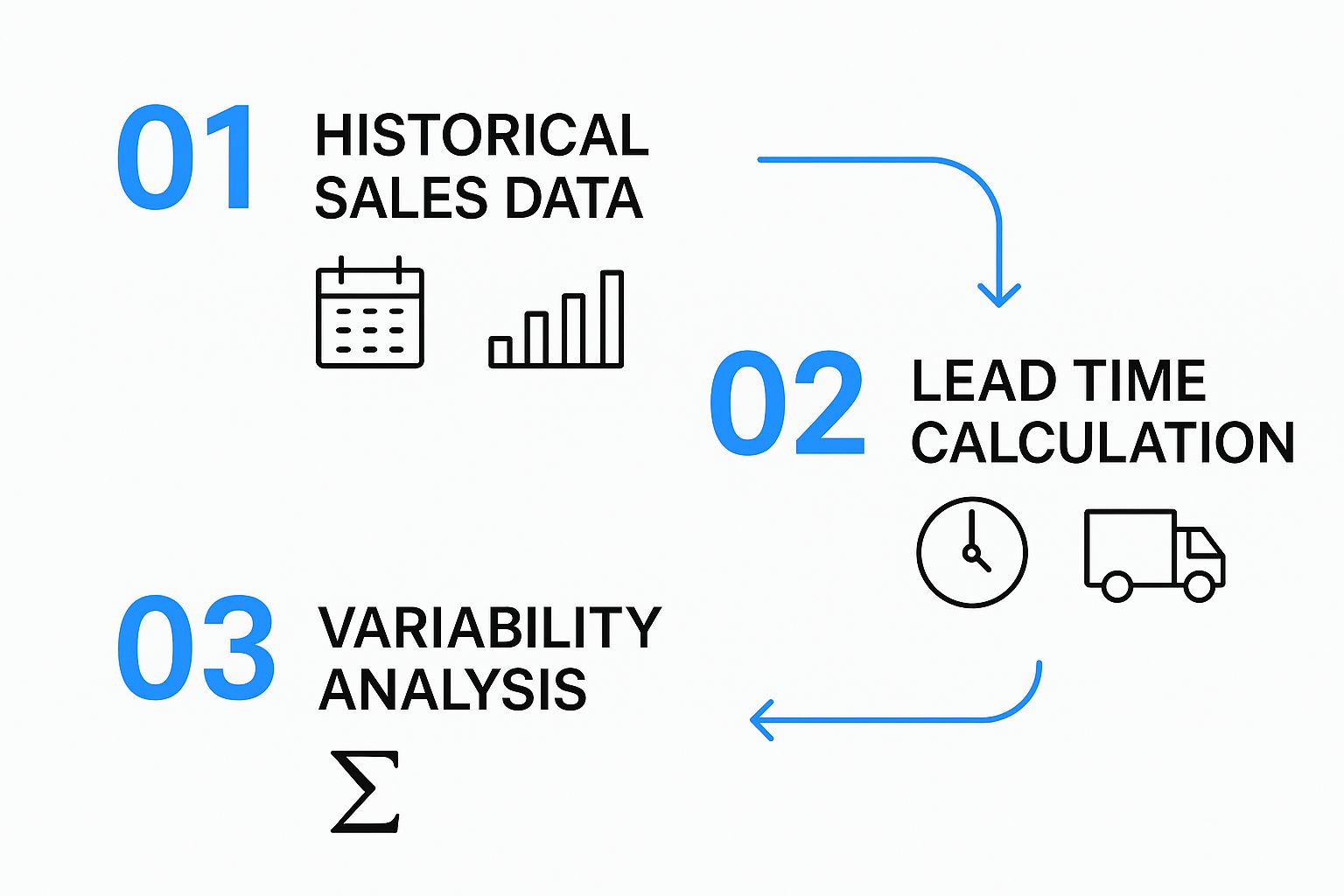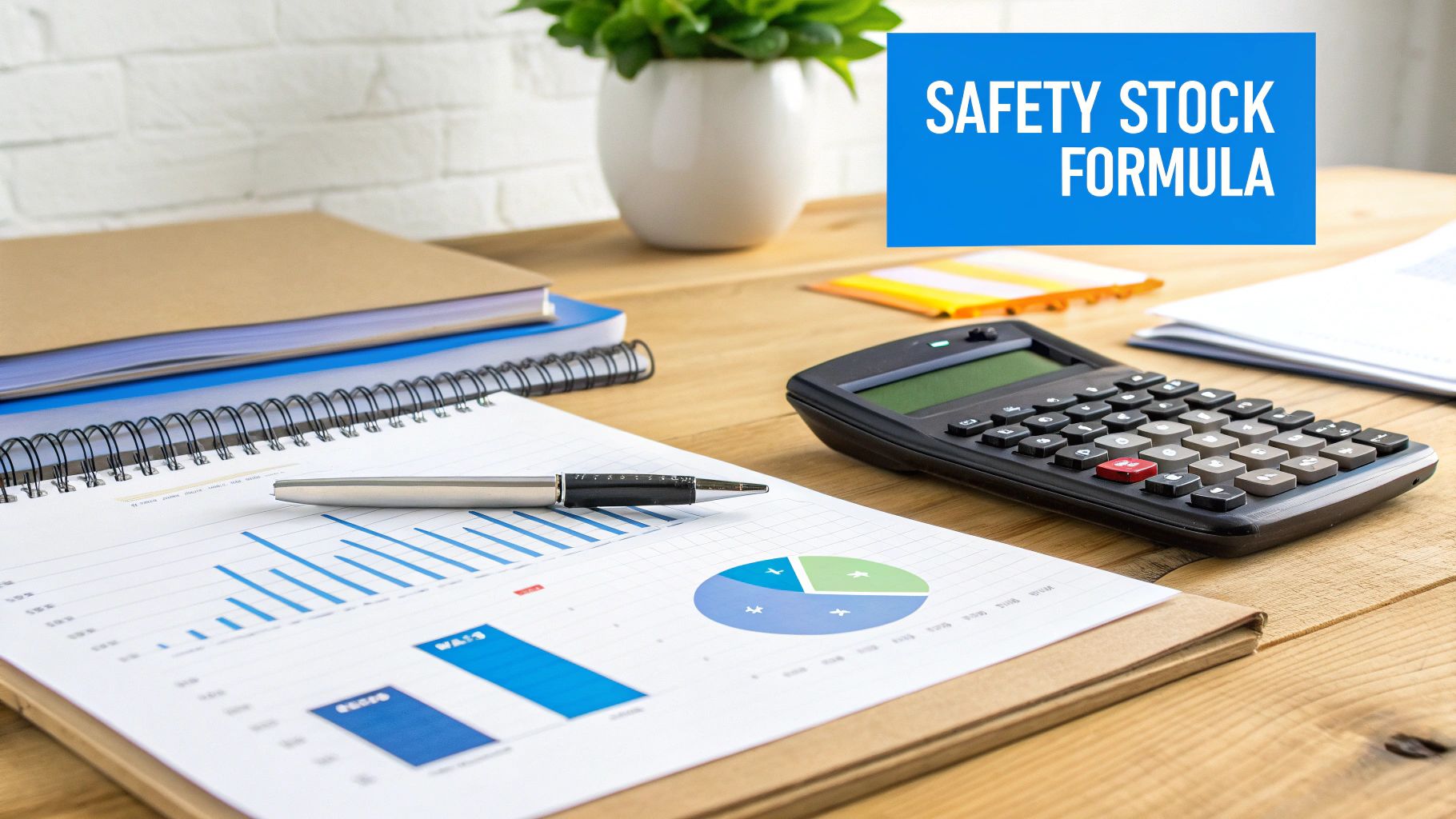Safety stock is the inventory buffer you keep on hand to protect your business from the two things you can never fully predict: sudden spikes in customer demand and unexpected delays from your suppliers. Think of it as your operational insurance policy—the key to avoiding costly stockouts and keeping customers happy.
Figuring out the right amount of safety stock is a fundamental skill for any e-commerce business. It’s what keeps your revenue flowing and your customer satisfaction high.

On a practical level, safety stock is the buffer that prevents a minor hiccup from turning into a major catastrophe. It stands between a smooth, reliable customer experience and a frustrating "out of stock" notification on your product page. Without it, even a small supply chain disruption can send ripples through your entire operation and damage your reputation.
The pain of running out of inventory is sharp and immediate. You lose sales, you frustrate loyal customers, and you risk a wave of negative reviews that can harm your brand's credibility. It’s not just a hunch; studies have shown that when an item is out of stock, 37% of shoppers will simply go buy it from another brand, sending revenue directly to your competition.
But swinging too far in the other direction—stockpiling inventory "just in case"—creates an entirely different set of expensive problems.
Excess inventory is much more than a space issue; it's a silent drain on your finances. Every unit collecting dust in a warehouse represents cash that could be fueling your growth through marketing, product development, or other investments.
Holding too much inventory leads to a cascade of negative financial consequences:
Imagine one of your products suddenly goes viral on TikTok. The inventory level that seemed perfectly safe yesterday is completely wiped out in a matter of hours. This is exactly where a well-calculated safety stock proves its worth. It gives you the wiggle room to capitalize on that sudden surge in demand without disappointing thousands of eager new customers.
Safety stock isn't just an operational metric; it's a strategic investment in customer retention and business agility. It's the calculated risk you take to ensure you can deliver on your promises, no matter what surprises the market throws your way.
Ultimately, learning how to calculate safety stock is all about finding that perfect balance. It’s about protecting your sales and keeping customers happy without crippling your business with the financial burden of carrying too much inventory.
Your safety stock formula is only as good as the data you feed it. Before you even think about plugging numbers into a calculator, you need to gather a few key metrics that reflect what’s actually happening in your business. Think of it like building a house—if the foundation is weak, the whole structure will be unstable.
It all starts with your sales history. I know it’s tempting to just pull the last 30 days of data because it’s easy, but that’s not going to give you the full picture. You really need to look at 12-24 months of historical sales data for every single SKU. Why so much? Because that longer timeframe is the only way to spot seasonality, see real trends, and understand the natural ebbs and flows of customer demand. A short-term view will completely miss the annual holiday rush or a predictable summer slump, leaving you either way overstocked or, worse, sold out at the worst possible time.
This visual guide breaks down the core data-gathering process.

From digging into sales history to analyzing those unexpected spikes and dips, each piece of information builds on the last, giving you a solid base for your calculations.
Next up, you have to figure out your actual lead time. This is not just the estimate your supplier gives you in an email. True lead time is the total time that passes from the second you hit "send" on a purchase order until that inventory is checked in at your 3PL and ready to be picked for a customer's order.
To nail this down, you’ve got to track the entire journey:
Getting this right is a game-changer for accurate safety stock, since any hiccup in delivery times directly messes with your inventory levels. If you want to go deeper, our guide on how to calculate lead time is a great resource. We see it all the time—businesses are shocked when they realize their actual lead time is days or even weeks longer than what their supplier quoted. Tools for understanding lead times can also shine a light on these often-overlooked delays.
Pro Tip: Don't let a crazy one-off event wreck your data. If you had a massive, unusual bulk order or a major port strike threw your timeline into chaos, consider pulling that data point before you calculate your average. If you don't, it will artificially inflate your safety stock needs for normal, day-to-day operations.
Finally, and this is the part people often skip, you have to account for variability. This is all about the natural, unpredictable swings in both customer demand and your supplier lead times. To measure this, you’ll need to calculate the standard deviation for both your daily sales and your lead times.
Don't let the term "standard deviation" scare you off. It’s just a simple way to measure how spread out your numbers are. A low standard deviation means things are pretty consistent. A high one means you're on a roller coaster.
Most spreadsheet software like Excel or Google Sheets has a built-in STDEV function that does all the heavy lifting for you. This number is what puts the "safety" in safety stock—it quantifies the uncertainty in your business so you can build a buffer that truly matches your risk level.

Alright, you've gathered your sales and lead time data. Now it's time to crunch the numbers and turn that raw data into a real, actionable inventory buffer. While there are a few ways to calculate safety stock, we'll start with a foundational method that’s both intuitive and surprisingly powerful for most e-commerce businesses.
This first formula gives you a solid baseline by looking at a worst-case scenario (your highest sales and longest lead time) and subtracting your average, everyday situation. That difference is your safety buffer—the extra stock you need to cover those unexpected sales spikes or supplier delays.
One of the most common and accessible methods is what I like to call the "Average-Max" formula. It’s perfect for getting a quick, reliable estimate without getting bogged down in complex statistics.
Here’s the formula:
Safety Stock = (Maximum Daily Sales × Maximum Lead Time) – (Average Daily Sales × Average Lead Time)
This calculation gets straight to the point by comparing your peak operational demands against your typical ones. It's an excellent starting point for any business that sees noticeable, but not totally wild, swings in sales and lead times. If you want a deeper dive into the core concepts, check out our complete guide defining safety stock.
Let’s walk through a quick example. Imagine your maximum daily sales hit 40 units and your longest lead time stretches to 40 days. Meanwhile, your average day sees 33 units sold with an average lead time of 35 days.
Plugging that into the formula:
SS = (40 x 40) - (33 x 35) = 1,600 - 1,155 = 445 units.
Based on this, you'd want to keep 445 units as a buffer. You can find more examples of this inventory calculation over at NetSuite.com.
For businesses that need more precision, especially those with more volatile sales or lead times, there’s a more statistically sound approach. This method incorporates standard deviation and your desired service level to quantify risk in a much more sophisticated way.
The formula looks like this:
Safety Stock = Z-Score × Standard Deviation of Lead Time × Average Daily Demand
Let's break down that new term, the Z-Score. This is a statistical value that represents your desired service level—basically, the probability that you won't stock out while waiting for your next shipment to arrive.
A 95% service level doesn't mean you'll fulfill 95% of all orders. It actually means you're accepting a 5% risk of stocking out during any given replenishment cycle. This is a critical distinction for setting realistic goals with your team.
Choosing the right service level is a strategic decision. You're balancing the cost of holding extra inventory against the very real cost of a lost sale and a disappointed customer. A higher service level means more safety stock and higher carrying costs, but you’ll sleep better at night knowing you can meet demand.
Don't worry, you don't need a degree in statistics to figure this out. For most e-commerce applications, you can just use a simple reference table that links your target service level to the correct Z-Score.
Here are the most common values we see in inventory management:
This is where you can get really strategic. You might aim for a 99% service level for your best-selling "hero" products but accept a 90% service level for slower-moving items to free up cash. This flexible, SKU-by-SKU approach lets you tailor your inventory strategy, ensuring you protect your most valuable revenue streams without overinvesting in less critical stock.

A formula gives you a number. Experience gives you the wisdom to know when that number needs a second look. The figure you calculate for safety stock is a fantastic starting point, but it should never be a static rule you set in stone.
The most successful e-commerce brands I’ve worked with treat their safety stock levels as a dynamic tool—something that needs to be constantly tuned based on market conditions, a product’s lifecycle, and your overall business strategy.
Think about a brand-new product launch. It’s packed with uncertainty. You have zero historical sales data and no real idea how customers will respond. In this case, your calculated safety stock might be dangerously low. It's often much smarter to be aggressive with your initial buffer for a new launch, even if it means higher carrying costs for a bit. The alternative is a stockout that could kill your momentum right out of the gate.
On the other hand, a mature product with years of stable sales history is highly predictable. For these steady sellers, you can lean on the formula with much more confidence. You might even be able to trim that buffer down, freeing up cash for other parts of the business.
Your suppliers are a massive variable in the inventory equation, and your formulas can’t read a supplier’s performance report.
Does one of your key suppliers consistently deliver five days late? If so, your standard lead time calculation is basically a fantasy. You have to manually adjust the safety stock for every product from that partner to account for their unreliability.
Don’t let a consistently late supplier burn you. If their average lead time is 20 days but they often take 25, you need to build your safety stock around the 25-day reality, not the 20-day promise. This simple adjustment prevents stockouts caused by their issues, not yours.
Seasonality is another critical area where you have to step in and override the math. Your safety stock for a popular holiday gift item should be significantly higher heading into Q4 than it is in February. Blindly following a year-round average will leave you sold out long before Black Friday even arrives.
The same logic applies to your marketing calendar. Are you planning a huge influencer campaign or a flash sale next month? These events are designed to create demand spikes that your historical data simply can't predict.
You need to proactively increase your safety stock levels for the promoted items weeks in advance. This ensures you can actually meet the surge in demand your marketing team is working so hard to create. An effective promotion that leads to a stockout isn’t a success—it's a missed opportunity and a fantastic way to frustrate new customers.
This kind of proactive thinking is a core part of understanding demand forecasting in ecommerce and aligning your inventory with your growth goals.
By regularly reviewing and adjusting your safety stock based on these real-world factors, you transform a simple calculation into a responsive, strategic inventory management system. It's the difference between constantly reacting to problems and getting ahead of them.
Even with the best formulas, a few common mistakes can completely undermine your efforts. Honestly, getting safety stock right is often less about complex math and more about sidestepping simple, costly errors. Knowing what these pitfalls are is the first step toward building an inventory strategy that's actually resilient.
One of the most frequent blunders I see is using incomplete data, especially for lead time. So many businesses only count the transit time from their supplier. They completely forget to factor in the crucial days it takes their own warehouse team to receive, inspect, and get that new inventory ready to ship.
Let's say your supplier's shipping time is 15 days, but it takes your 3PL another 3 days to process the shipment. Your true lead time is 18 days. Using the wrong number throws off your entire calculation, leaving you dangerously exposed to stockouts.
Another classic error is treating safety stock as a one-time calculation. Your business isn't static, and neither are your inventory needs. Market demand shifts, supplier performance changes, and new products launch all the time.
Your safety stock levels need regular check-ups. For most products, a quarterly review is fine, but for your best-sellers or seasonal items, you should be looking at them monthly.
Setting your safety stock once and never looking at it again is like setting a course on a ship and never checking for wind or currents. You will inevitably drift off course and end up in a place you didn't intend to be.
Finally, please avoid the temptation of a one-size-fits-all policy. Applying the same safety stock percentage to every single SKU is a recipe for disaster. Your high-margin, fast-moving "hero" product deserves a much larger buffer than a slow-selling, low-priority item.
A tailored approach prevents you from tying up precious capital in products that just don't need the extra protection. When you differentiate your strategy, you can invest your inventory dollars where they'll have the biggest impact on revenue and customer satisfaction.
Failing to do this often leads to the worst of both worlds: overstocks on some items and stockouts on others. For a deeper look at the consequences, it's worth understanding the key differences between backorders vs out of stock scenarios and how they impact your brand. By sidestepping these common errors, you move from just calculating a number to building a smart, dynamic inventory system.
Even after you've crunched the numbers, the real world of inventory management always throws a few curveballs. This is where theory meets reality. We get a lot of the same questions from e-commerce brands who are just starting to get serious about their safety stock strategy, so we’ve put together some quick answers to those common "what-if" scenarios.
Think of this as the practical advice you need to move from the spreadsheet to the warehouse floor with confidence. Let's tackle some of the most pressing questions you're probably thinking about.
Calculating safety stock isn't a "set it and forget it" task—it’s a living part of your inventory strategy. For most of your products, a quarterly review is a great starting point. This cadence is frequent enough to catch major shifts in sales trends or supplier reliability without bogging you down in constant analysis.
However, for your A-list products—those best-sellers, seasonal stars, or items you're pouring ad spend into—you need to be more proactive. A monthly review is essential for these SKUs. It lets you stay nimble and adjust your buffers before a big holiday rush or marketing campaign, ensuring you don't run out of stock right when demand is peaking.
Picking a service level is all about balancing the desire to never disappoint a customer against the real-world cost of holding inventory. It’s a classic tug-of-war. For most e-commerce businesses, a service level between 90% and 95% hits the sweet spot.
This range gives you a strong defense against stockouts across the majority of your catalog without tying up too much cash in products that don't move as quickly.
But for your "hero" products—the ones that define your brand and drive the most revenue—you need to play a different game. For these critical SKUs, aim higher. Targeting a 98% or even 99% service level ensures they are almost always available to protect your most important income streams.
Technically, yes, safety stock can be zero. But in the real world of e-commerce, it's a high-wire act with no safety net. This strategy really only works under a couple of very specific, and very rare, conditions:
For pretty much everyone else, running with zero safety stock is like driving without a spare tire. Sure, it saves a little space, but one unexpected hiccup can leave you stranded, unable to fulfill orders and damaging your brand's reputation.
Ready to stop guessing and start managing your inventory with precision? Simpl Fulfillment provides the real-time data and expert support you need to optimize your safety stock, prevent stockouts, and scale your brand confidently. Learn how our 3PL services can transform your operations.